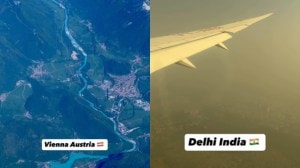Advani bares Pak role in hijack
NEW DELHI, JAN 6: Six days after the end of the hijacking crisis and in the shadows all this while, the Union Home Ministry has come out w...

NEW DELHI, JAN 6: Six days after the end of the hijacking crisis and in the shadows all this while, the Union Home Ministry has come out with what it claims is “irrefutable evidence” of Pakistan’s “direct involvement” in the incident.
Home Minister L K Advani on Thursday released photographs of the five alleged hijackers saying that all were residents of Pakistan and that the hijack was essentially an ISI operation carried out with the assistance of the Harkat-ul-Ansar. Its starting point,he claimed was Mumbai and not Kathmandu.
Despite this statement, a few vital questions such as the bungling at the Amritsar airport and the complete intelligence failure remain unanswered. According to the Government, Pak authorities (through their embassy in Nepal) were in touch with the hijackers from the day they boarded the Indian Airlines plane at Kathmandu. It is alleged that the hijackers got every possible assistance from Pakistan at each turn of the week-long hijacking drama. The crucial lead thatestablished the identity of the five hijackers, the Government says, came from Mumbai with the arrest of four ISI operatives who apparently provided support to five hijackers.
The five hijackers have been identified as Ibrahim Athar (the chief hijacker, resident of Bahawalpur in Pakistan and brother of released militant Maulana Azhar Masood), Shaqir (from Sukkur city) and three Karachi residents Shahid Akhtar Sayed, Sunny Ahmed Qazi and Mistri Zahoor Ibrahim. Incidentally, at least three of them figure in the airline’s manifest that was sent to New Delhi.
According to the Government, on the night of December 29, when the plane was in Kandahar, one of the arrested Mumbai-based operatives made a telephone call to a TV correspondent in London that if the hijackers’ demands were not met, the plane would be blown up. “We promptly followed up the cue and the four were rounded up,” Advani said. Once the arrested ISI agents spilled the beans, the Government says, it was easy to dig out the hijackers’photographs from records. The photographs, officials insist, have been shown to the released passengers and their identities confirmed.
As for Pakistan’s complicity in the hijacking, the Home Ministry points to “at least six tell-tale pointers”. These are:
The four alleged ISI operatives arrested after the Mumbai police intercepted their call to London are Mohammed Rehan, Mohammed Iqbal, Yusuf Nepali and Abdul Latif. Of these, Yusuf is a Nepali national. They disclosed that the preparation for the hijack was spread over nearly two months and one of them, Abdul Latif, made several trips to Kathmandu during this period. In fact on November 1, according to the HomeMinistry’s statement, chief hijacker Ibrahim Athar was in Mumbai. On this day, Latif and Athar flew to Calcutta, from there took a train to New Jalpaiguri and then boarded a bus to Kathmandu. On his next trip, Latif escorted Syed Akhtar Shahid (another hijacker) to Kathmandu.
Hijacker Shakir, along with Latif, apparently took a different route: they arrived in Gorakhpur in eastern Uttar Pradesh by train and from there, took a bus to Kathmandu. Finally, on December 17, Latif took a Kathmandu-Delhi Indian Airlines flight and returned to Mumbai by train. The Government, Advani said, was determined to see that terrorism in Jammu & Kashmir was completely smashed out. “The war against terrorism,” he said, “has been a protracted one, always and everywhere in the world…But experience the world over has shown that a terrorist movement, confronted by organised state power, is always subject to the law of decreasing returns and increasing risks. They should know that they have no hope of winning against the mightof the Indian State, complemented by the equal might of the unity and patriotic resolve of the Indian people.”



- 01
- 02
- 03
- 04
- 05




























